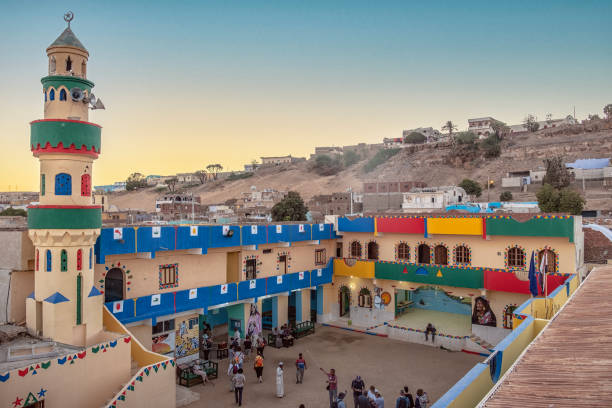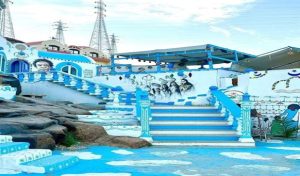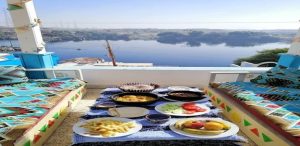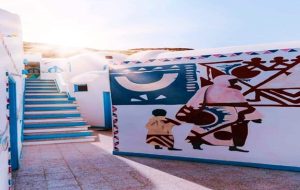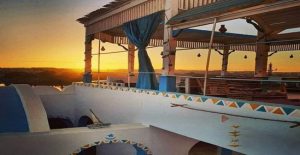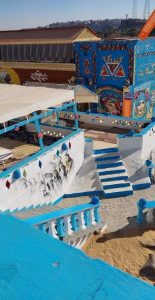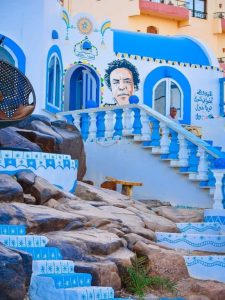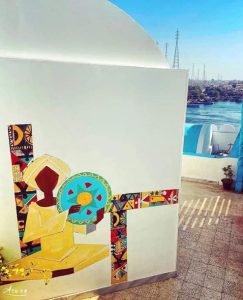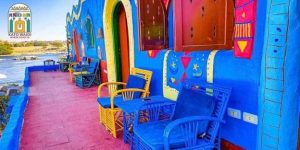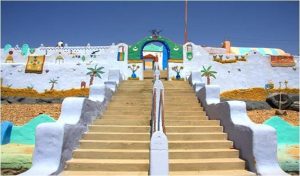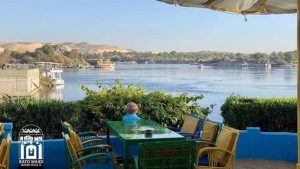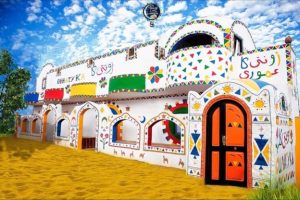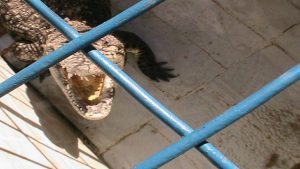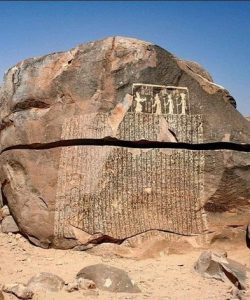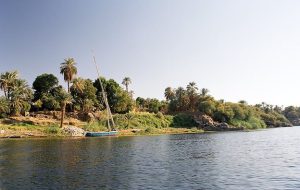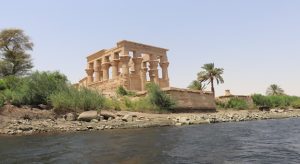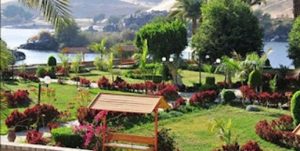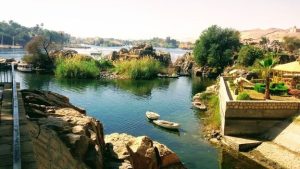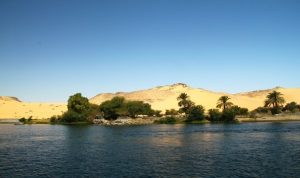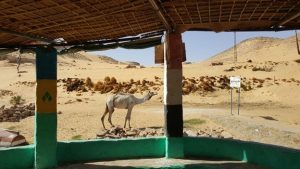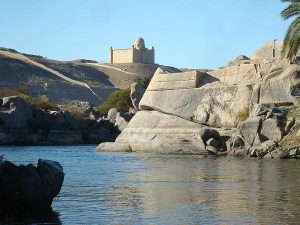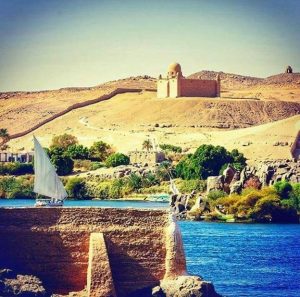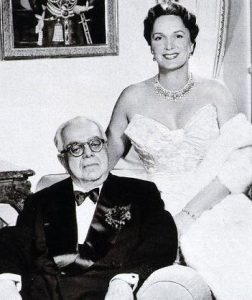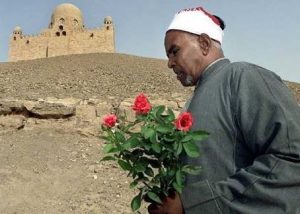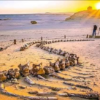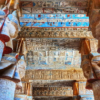The Nubian Village
When the High Dam was built, one of its harms was the displacement of the Nubians from their homes located on the banks of the river between the site of the High Dam and the Egyptian border with Aswan. Therefore, a city called Nasser City was built for them in Aswan, and some of them settled in Kom Ombo, Edfu, and Aswan. However, as usual, they did not leave the Nile River, so they built villages on islands in the Nile River, especially Soheil Island. Their houses on these islands became famous for their beautiful colors on the banks of the Nile, and their spice shops and cafes. The place was built in the style of traditional Nubian architecture using mud bricks, a mixture of mud, water, straw, and sand.
An Aerial View of the Nubian Village
The Nubian villages are located amidst lush palm groves, and their houses are painted in blue, pink, or yellow. Often, chickens are seen eating in the dirt and goats roam around these houses. The alleys are made of mud bricks, and the previous fenced gardens adorn the place, which means that the main attraction for tourism here is the Nubian house. You can visit rural schoolrooms and other basic ones equipped with minimal equipment, which reflects the simple lifestyle of the people. The Nubians are famous for henna, and therefore, we find many of them specializing in henna work at all times, especially on wedding days. Visitors can get a tattoo or henna done at any time.
Picture for The Nubian Village
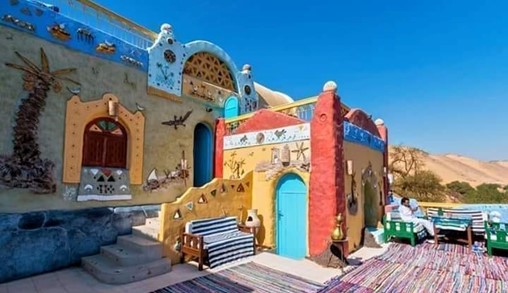
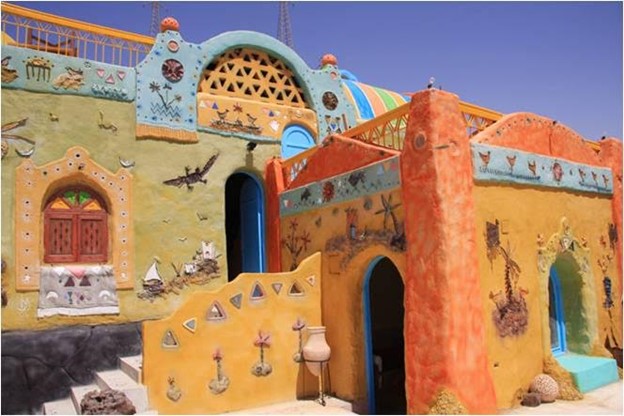
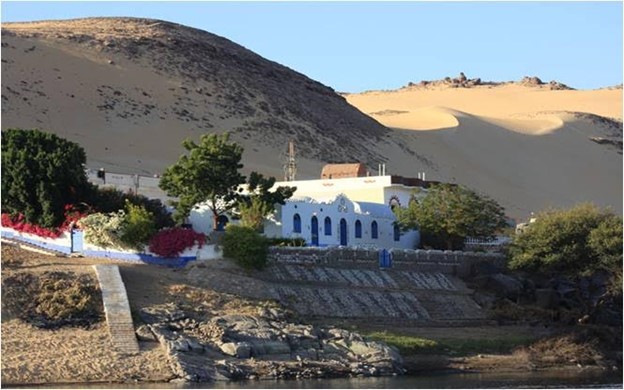
One of The Nubian Village’s houses from inside
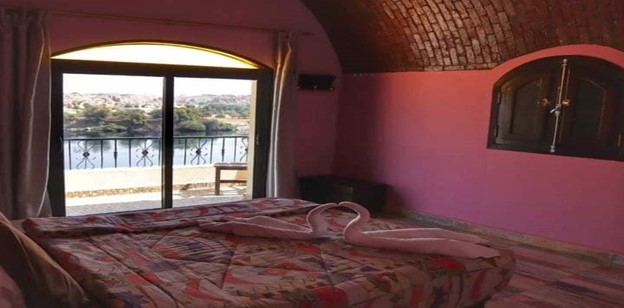
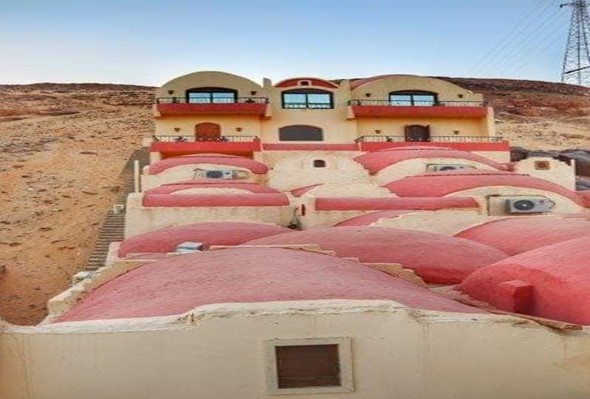
One of The Nubian Village’s houses from outside
Pictures for The Nubian Village
There are also some small crocodiles that we can see in the Nubian village, and we can also have drinks or shisha there
Seheil Island
Seheil Island is located to the north of the old Aswan Dam. Its significance lies in the fact that travelers used to leave inscriptions or prayers of thanks on the granite hills found in several areas of the island. There are over 250 inscriptions for the god Khnum dating back to the Middle Kingdom (around 2200 BC) until the Ptolemaic era (around 30 BC).
The Famine Stela
The Famine Stela
The ancient Egyptians were accustomed to the Nile bringing them abundant goodness, as it flooded every year with enough to cultivate, drink water, and fish from its waters. In some times and periods, the Nile did not flood enough for the land of Egypt, and this period lasted for seven years each time, so the Egyptians called it periods of famine. The oldest known text among the ancient Egyptians about periods of famine was in the era of King Djoser, 2800 BC. The story tells that a famine occurred during the king’s reign, but his wise vizier Imhotep decided to build grain silos to store the grain. Each year’s harvest would be enough for the current year and the next, until the famine ended, and they would take some and save some for the following year. As a result, the Egyptians did not feel the periods of famine. The Egyptians wrote stelae of thanks to King Djoser and his vizier Imhotep, who became a god in the Ptolemaic era and was considered the god of medicine. They built temples for him and sanctified him. We see this here on Seheil Island, where there is a stela called the Famine Stela, inscribed in Egyptian hieroglyphs. The story of the famine that occurred during the reign of King Djoser was written in the Ptolemaic era, from around 332 to 30 BC.
Some of ancient remains in Elephantine Island
Botanical Garden
Located west of Elephantine Island, it is called the Botanical Island or Kitchener Island, named after the British governor who ruled Sudan, and his headquarters were in Aswan. He established this beautiful garden and named it Botanical Island in 1952 AD. It is located on an area of 17 acres and has 27 agricultural basins containing various trees and woody, tropical, aromatic, and ornamental plants. There is also a botanical museum and a library. While strolling, one can enjoy the natural scenery of the garden, with green trees, the blue waters of the Nile beside it, and yellow sands to the west. It is also full of birds and has many plants imported from the Far East, Africa, and Latin America. The most important Egyptian tree there is sandalwood. There are also a number of rare palm trees such as the royal palm and the soap palm. From the island, one can see the Saluga Nature Reserve.
Saluga Nature Reserve
One of the most important natural reserves in Egypt it is considered one of the most beautiful natural places in the city of Aswan. The reserve is characterized by its large area, in addition to its breathtaking views and fresh air, and can be enjoyed day and night. It contains many types of rare wild plants and birds. There is also a group of rare animals, which adds a special beauty to the reserve, especially birds, geese, and some wonderful fish. You can stay there through camps and enjoy riding camels.
Scene from Saluga Nature reserve
Aga Khan’s Tomb
On the western bank of the Nile River lies the most beautiful modern tomb in Egypt, the tomb of the Aga Khan. Aga Khan (Muhammad Husayn Shah Ali) is the grandson of Hasan Ali, who founded a sect in India called the Ismaili sect, one of the branches of Shiism. They were merchants in India and were known as Bohras, “meaning spice merchants”, and they became extremely wealthy. When choosing their prince, the Aga Khan, they would weigh him in gold and give him gold equal to his weight. The Aga Khan became the richest person in the world, and his wealth was estimated to be many times that of all the rich people in the world. The Bohra sect renews the Al-Hakim Mosque in Cairo every year, which is considered sacred to them. Anyone who visits the mosque now will see that it has become the richest and most magnificent mosque in Egypt. Prince Muhammad Husayn, known as the Aga Khan, married an Italian girl who bore him a son, Ali, who married the famous actress Rita Hayworth in the 1940s but died young in a car accident. He then married another French woman who bore him a son, Sadruddin. His grandson, Karim Aga Khan, is now one of the judges of the International Criminal Court. In 1942, he met a beautiful girl who was selling flowers. He loved her and married her. Her name was Labruso, and she converted to Islam and changed her name to Begum Om Habiba.
The Aga Khan and Aswan
The Aga Khan suffered from rheumatism and bone pain, and his millions could not cure him. A friend advised him to visit Aswan. The Aga Khan came to Aswan around 1954 AD, accompanied by his wife, entourage, and a large group of followers of the Ismaili sect. The Aga Khan was unable to walk and moved in a wheelchair. He stayed at the Old Cataract Hotel, the most luxurious hotel in Aswan at that time and until today. They brought him the wisest of the Nubian sheikhs in matters of medicine. The sheikh advised him to bury his lower half in the sands of Aswan for three hours daily for a week, amidst the ridicule and resentment of foreign doctors. The Aga Khan followed the advice of the Nubian sheikh, and after a week of daily burial, the Aga Khan returned to the hotel walking on his feet, surrounded by the immense joy of his wife, supporters, and followers. From then on, the Aga Khan decided to visit Aswan every winter. However, he was not content to be a patron of hotels. He asked the governor of Aswan at the time to buy the area where he was being treated, and the governor of Aswan agreed to the request. The Aga Khan brought engineers, architects, and workers to build him a tomb to immortalize his memory in the area that had healed him from his illness. At the forefront of the engineers was the Egyptian professor, Farid Shafei, who designed the tomb based on the Islamic Fatimid architectural heritage, as per the Aga Khan’s wish. He bequeathed that he be buried in this tomb upon his death. He died in 1957, and the tomb was not completed at that time. So he was buried in Switzerland. When it was completed in 1959, he was transferred to his tomb in Aswan. His wife used to place flowers on his grave every day herself. She was very loved by the people of Aswan because she used to feed the poor. When she grew old, she would come to Egypt for periods, and someone would substitute for her in placing flowers on his grave until she died in the 1990s.
Location of the Aga Khan’s Tomb
He built a palace for himself on the Nile and on the western side, he built his tomb which was designed in the Fatimid architectural style, using pure marble. The tomb overlooks the old palace of King Farouk, which is now the Cataract Hotel, and on the other side overlooks a Roman-Greek cemetery and the Temple of Satet, which was built by Queen Hatshepsut.
the Aga Khan and his beloved wife
the Aga Khan’s Tomb

